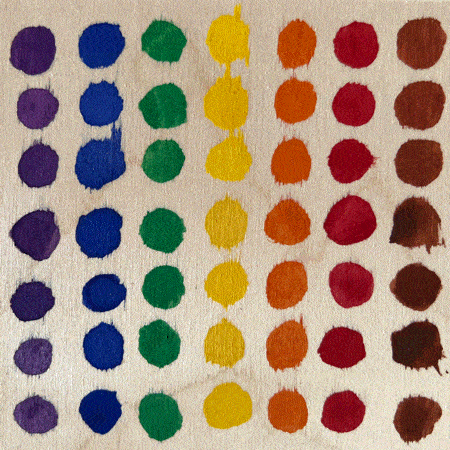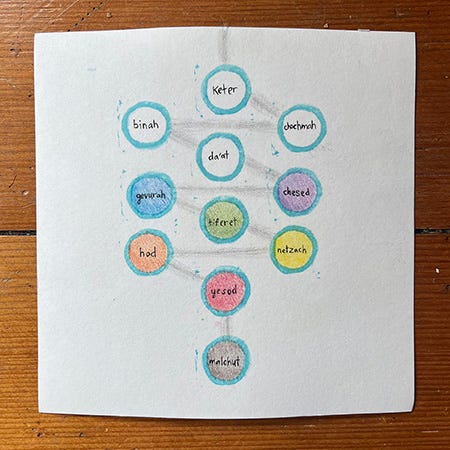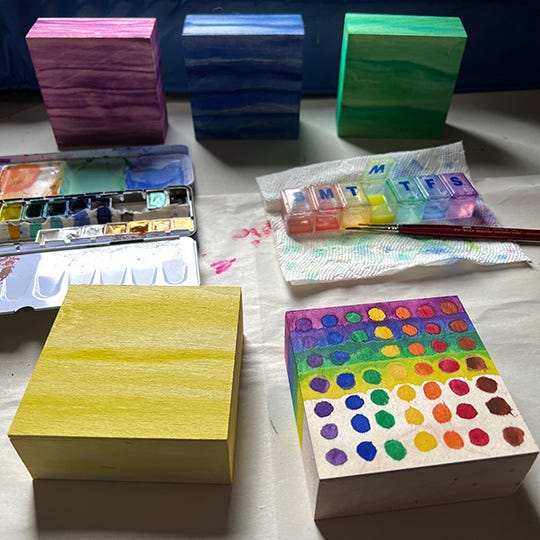A theme seems to be emerging in this new series of monthly essays: Games. I happened to title the first one “Go Fish,” from when my kid asked if Tarot is played facedown like a card game. The next one I wrote about my newfound solace in the old mobile phone game, “Threes.” This month I find myself enmeshed in another game, an even older, more explicitly spiritual game: Counting the Omer.
This game is a little bit more technical to explain than the other two. I’ll give it a try.
What is Counting the Omer?
The word “omer” technically refers to a unit of measurement of barley, as well as the name of the 7-week period between the Jewish holidays of Passover and Shavuot. In fact, the word “Shavuot” literally means “weeks” in Hebrew. So why the barley and why the weeks?
Passover commemorates the Israelites’ liberation from slavery in ancient Egypt and Shavuot commemorates their receiving the Torah in the Sinai desert. Passover and Shavout are also each agricultural festivals, with Passover marking the first barley harvest in the spring and Shavuot marking the first wheat harvest.
On the second day of Passover, priests at the Holy Temple made a “wave offering” of an omer of the first barley harvest, waving it in the six directions: north, east, south, west, up, and down. Only then could that year’s barley harvest be eaten. After that, it was commanded to ritualistically count each day for 50 days until Shavuot when the wheat harvest would be ready, the most important harvest of the year. In this way, the Omer links the barley harvest to the wheat harvest, and links the Divine to the Earth as a sustaining lifeforce.
These harvest offerings and most other priestly rituals ended when the Second Temple was destroyed in 70 CE, but the practice of counting remains. This is called Counting the Omer and it entails, well, counting. Literally. Every night (on the Hebrew calendars, days start at sundown instead of at midnight) you say a blessing and then count the day and week, like so:
“Today is Day One of the Omer.”
“Today is Two Days of the Omer.”
On and on until:
“Today is Forty-Eight Days, which are Six Weeks and Six Days of the Omer.”
“Today is Forty-Nine Days, which are Seven Weeks of the Omer.”
The Grid
Remember, Passover and Shavuout have agricultural significance as well as historical, linking to a grand narrative. In the Passover story, you could say that after the Israelites were free they were still in need of a lot of healing before they were ready to receive the Torah fifty days later. Going from slavery to freedom is not simply a physical designation but a mental and spiritual transformation.
In the 16th century, Kabbalists (Jewish mystics) noticed the neat correspondence of the seven weeks of the Omer with what they regarded as the seven accessible holy attributes of the Divine, or the seven lower sephirot. The sephirot are all connected to each other in this Tree of Life diagram, where the Divine spark enters at the top and comes down to the world like a lightning strike to the bottom:
These attributes are hard to translate, and like any Jewish concept, there are endless opinions about what they might mean. Here is a rough guide of the sephirot:
1. Chesed - Lovingkindness, Unconditional Love, Grace, Mercy
2. Gevurah - Strength, Judgment, Boundaries
3. Tiferet - Harmony, Balance, Beauty
4. Netzach - Eternity, Endurance, Dedication, Ambition
5. Hod - Splendor, Awe, Humility, Acceptance, Order
6. Yesod - Foundation, Creativity, Bonding, Sexuality
7. Malchut (Shekhinah) - Divine Presence, Physical Reality, Manifestation, Leadership
If each week has an overarching attribute, then each day of the week it pairs with one of the other attributes, cycling in a 7x7 grid to create 49 pairs of spiritual themes.
It starts with Chesed she’b’Chesed (Lovingkindness within Lovingkindness), then goes on to Gevurah she’b’Chesed (Strength within Lovingkindness), cycling through each week. Considering each day’s theme and chanting its name along with counting the Omer turns it into a sort of spiritual fitness calendar, preparing practitioners to receive revelation every year at springtime just as the Israelites might have been made ready to receive the Torah at Sinai:
If you’ve been following Rainbow Squared, that structure may look and sound familiar to you. Yes, I accidentally intuited a Kabbalistic practice when I found my way into what I now called Rainbow Squared. It progressed naturally enough, starting with one painting a day seven days a week for seven weeks using one color for each day of the week. Then I turned it into one painting a week for a year using two colors from a rainbow grid and exploring the meanings of the colors, and it was pretty much the same structure as the Kabbalisitic matrix for Counting the Omer.
I had known about the counting of the days, but I didn’t really know about the sephirot or the matrix, and I certainly had never seen it represented in colors. In that way, the Omer did not consciously influence the Rainbow Squared grid, but here it is, and pretty unignorable.
Colors aren’t always part of Counting the Omer though. There are just as many color associations as there are potential meanings for each of these sephirot. In some systems, colors are determined individually without any overall order, and in others they follow a spectrum. The grid I made above uses the colors determined by Rabbi Zalman Shachter-Shalomi, or Reb Zalman, the founder of the Jewish Renewal movement, as most famously laid out in his rainbow tallit design.
I keep wondering whether the sephirot would feel right in Rainbow Squared colors. Maybe I’ll try it next year.
In Practice
It was only last year that I counted the Omer for the first time. I joined a virtual cohort of other queer creatives to do it, resulting in a digital zine: A New Gift. I was in the midst of making weekly pieces for Year 5 of Rainbow Squared, so I wove in the significance of each week’s sephira into that week’s essay, creating an additional animation using its designated color. This practice was made more chaotic given that last year I was following Rainbow Squared in an emergent order, creating pieces for color pairs at random instead of the progression of the grid. I thought of it sort of like Rainbow Cubed.
It was a lot.
This year, I had some fantasies of doing a 49-day sprint of artmaking for the Omer. Because I am taking a break from making weekly pieces, I thought a piece a day might be a meaningful and (dare I say) efficient way to engage with the grid again.
Then on the first night of the Omer this year, the second night of Passover, I found myself standing at the trunk of my car underneath the full moon at my friend’s wedding. I had just wrestled two sugar-high kids to sleep and had my prayer beads and my baby monitor both hanging around my neck, ready to Count the Omer.
The theme for the first day of the Omer is always Chesed sh’b’Chesed: Lovingkindness within Lovingkindness. It is customary to chant the name of each spiritual theme 112 times when counting the Omer. (18 x 6 + 4 = 112. 18 is for “chai” which is the Hebrew word for “life” and 6 is for the six directions. 18 x 6 =108, which is already a holy number in many cultures, then you add 4 for the letters in the unpronounceable name of the Divine.)
As I gazed at the moon chanting “chesed” to myself again and again, I laughed, knowing that the true way to practice lovingkindness this year would be not to force myself to take on a piece a day, in any medium. Counting and chanting is enough.
Though I guess I am also painting a 4x4 inch wooden canvas every week, sure.
Today is the 22nd day of the Omer, and the attribute is Chesed sh’b’Netzach. Lovingkindness within Endurance. Yellow Purple. It’s also the first quarter moon. So here I am, waking up at 4:30am on Mother’s Day to finish this piece since I have committed to monthly essays using that moon as a deadline. I am typing this sentence in particular on my phone back in bed while nursing my kid who summoned me pleadingly from my desk at 630am.
Not pushing myself past my limit is Lovingkindness, and so is honoring my own deadlines. Nursing and writing feels like a pretty good example of Lovingkindness within Endurance.
I’m still figuring out how the colors connect the Omer and Rainbow Squared, but I will say that today’s Yellow Purple is one of my favorite combinations: complementary colors, and the Power of Magic to boot. As I continue to explore this creative spiritual system of my own making, it’s pretty magical to be connected back to the earth-based ritual of my ancestors. It’s a reminder that religious practice itself is magical practice: what else can you call superstitiously waving barley in hopes for a bountiful wheat harvest?
If I’m being honest though, I’m not sure I will have a particularly bountiful spiritual harvest from this year’s Omer. You get what you put in, and while it is certainly a commitment to remember to say a prayer and chant a theme 112 times 49 nights in a row, without artmaking to go along with it I find the themes aren’t really penetrating. But who the hell can concentrate on anything right now when everything is burning, literally and figuratively?
Maybe the Omer isn’t just about reaping some specific spiritual benefit every night. It’s a durational game, a complete arc, and we’ve got 28 days to go. The next moon that I write to you, Shavuot will have just passed and with it another wedding. Plus, in other divine timing, a copy of the book Counting the Omer by Rabbi Min Kantrowitz finally arrived in the mail last night. Next first quarter moon I might have a different perspective.
🌓
In Other News
Also during this Omer, I was on a podcast. The interview itself was actually last year, but it was edited and released last week. Remember that time an audio producer friend got a soundbite of me and I was so afraid I might sound racist that I didn’t listen to the piece for six years and then when I did I wrote an essay about it for Black White Orange? Well, that audio producer is Zak Rosen and I went on his podcast, the Best Advice Show to talk about how creating and committing to a structure for a creative practice is key to making it happen, especially when you are busy doing things like parenting.
Speaking of parenting and being as it’s Mother’s Day, and because I just discovered I can make buttons in these posts: if you like or learn anything from Rainbow Squared, consider donating 49 or 7 or 18 or 112 dollars to Michigan Reproductive Freedom for All in my original home state:
Overturning Roe v. Wade would immediately put a 1931 Michigan law back into effect that would make abortion illegal there and threaten doctors with prison for up to fifteen years for providing one. It will take time, but amending the state constitution could protect the right to abortion and (staying on the theme of this post) protect religious freedom. Did you know that in many cases Jewish law doesn’t just allow abortion, but demand it?
Until next moon.
✨
This ended up being the first of a multi-part series. Next check out Counting the Omer, Part Two or Omer 2021/5781 Animations.







